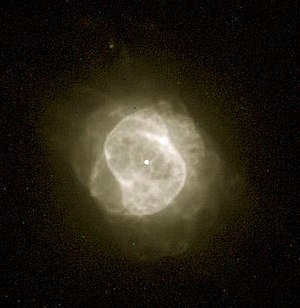NGC 6884
| NGC 6884 | ||
|---|---|---|
 | ||
| Datos de observación: Época J2000.0 | ||
| Ascensión recta | 20h 10m 23.7s | |
| Declinación | +46°27′39.8″ | |
| Distancia | 6500 al aprox | |
| Magnitud aparente (V) | 12,5 | |
| Tamaño aparente (V) | 6 segundos de arco | |
| Constelación | Cygnus | |
| Características físicas | ||
| Otras designaciones | NGC 6766 / PK 82+7.1 | |
NGC 6884 es una nebulosa planetaria en la constelación de Cygnus de magnitud aparente +12,5. La distancia a la que se encuentra varía entre 4600 y 15 700 años luz según la fuente consultada, pudiéndose adoptar la distancia de 6500 años luz como valor medio entre las distintas distancias publicadas.[1]
La imagen de la nebulosa muestra un brillante núcleo elíptico con dos lóbulos de emisión de intensidad diferente, orientados aproximadamente en dirección este-oeste, rodeados por un halo extendido de unos 70 segundos de arco de tamaño. Las imágenes en alta resolución demuestran que la nebulosa es extremadamente grumosa y filamentosa, y que posee un caparazón central elíptico. Todos los datos concuerdan con que las espirales representan dos flujos bipolares con una velocidad de expansión constante de unos 55 km/s, pero existiendo un movimiento de precesión cuyo período es uno de los más cortos que se conocen.[1]
La estrella central, de magnitud de 15,6, tiene una temperatura efectiva aproximada de 100 000 K.[2] Las determinaciones de los contenidos de distintos elementos químicos sugieren un enriquecimiento en carbono, nitrógeno y neón, y un empobrecimiento en cloro y azufre.[2]
Este objeto tiene una entrada doble en el catálogo NGC: como NGC 6884 y como NGC 6766. Esta nebulosa fue descubierta en el año 1883.
Véase también
[editar]Enlaces externos
[editar]Referencias
[editar]- ↑ a b Miranda, L.F., Guerrero, M.A. & Torreles, J.M. (1999). «Multiwavelength Imaging and Long-Slit Spectroscopy of the Planetary Nebula NGC 6884: The Discovery of a Fast Precessing, Bipolar Collimated Outflow». The Astronomical Journal 1117. pp. 1421-1432. (enlace roto disponible en Internet Archive; véase el historial, la primera versión y la última).
- ↑ a b Hyung Siek, Lawrence H. Aller, Walter A. Feibelman (1997). «The Spectrum of the Planetary Nebula NGC 6884». The Astrophysical Journal Supplement Series 108 (2). pp. 503-513. (enlace roto disponible en Internet Archive; véase el historial, la primera versión y la última).
Text is available under the CC BY-SA 4.0 license; additional terms may apply.
Images, videos and audio are available under their respective licenses.
